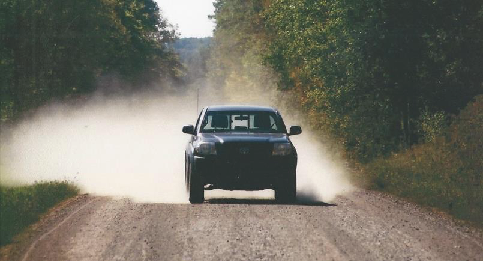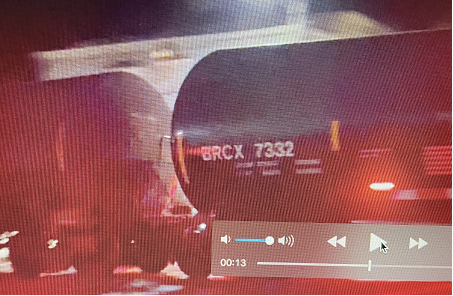The Fracking Industry’s Water Nightmare
September 25, 2018Anticipatory Nuisance Claim Allowed Against Frac Sand Mine
November 12, 2018A variety of methods are currently being employed to dispose of oil and gas well brine (OGB), a byproduct of all gas and oil drilling, including conventional and fracked wells. One such practice is spreading OGB on unpaved roads for dust control and road stabilization. Application on roadways is common, and locally important in some areas, including at least the states of Michigan, New York, Ohio and Pennsylvania.
This “brine” is actually liquid gas or oil drilling waste or “produced water”. It contains heavy metals, extreme levels of salt, endocrine disruptors and radioactive materials. Drillers usually have to pay to dispose of OGB, so dumping it on local roads is money in their pockets.

Dust from unpaved road in NW PA treated with OGB no more than 6 days before this photo was taken shows the ineffectiveness of OGB in controlling dust.
Recent research, supported by DCS, shows that spreading OGB on unpaved roads is ineffective and likely counterproductive for dust control and road stabilization (see Part 1: Ineffectiveness) and presents numerous potential and immediate environmental, health and economic risks (see Part 2: Environmental and Health Impacts). Locally, this research has bearing on the import of frack waste into NY State (allowed even though fracking is banned), brine spreading in western PA and the DRBC’s inclination to allow the import of frack waste into the Delaware River Basin.
Conclusion of Oil and Gas Well Brines for Dust Control on Unpaved Roads – Part 2: Environmental and Health Impacts by Bryce F. Payne, Jr., PhD
“The very limited available data and more thorough related literature clearly indicate OGB is not an effective dust-control agent (Payne 2018) and has verified environmental and foreseeable health risks when applied at rates currently considered acceptable by state regulators, even without considering that enforcement of state OGB application rate limits is rare. Rudimentary analysis indicates the practice is not cost effective, and in many cases will be counterproductive with regard to road stabilization. It is, therefore, difficult to view the use of OGB on unpaved roads for dust control and road stabilization as anything more than a legacy oil- and gas-well waste-water disposal practice with substantial environmental and foreseeable health risks, especially health risks of exposure to dust from OGB-treated roads. Further, it is important to recognize the use of OGB for dust control is an insidious practice in that it is presumed to reduce dust when in most cases it will increase dust, which will lead to the conclusion more OGB is needed. Due to the sodium saturation of road soil after prolonged periods of OGB treatment, it can be anticipated that cessation of the practice will likely result in increased dust and calls for resumption of OGB spreading when that is exactly the wrong course.”
Here’s a summary of the papers by the author:
Let me be clear. I did limited investigative work along with a substantial literature review and examination of published data on the effectiveness and environmental impacts of use of oil and gas field (O&G) brine as a dust suppressant on unpaved roads. I did NOT look at effectiveness as a deicer on paved roads. Some environmental impacts are, or are reasonably foreseeable to be, common to both use as a dust suppressant and as a deicer. Other impacts are relatively specific to each use, e.g., contamination of road dust, increased human/environmental exposure to contaminants in dust along unpaved roads treated with O&G brine. My main conclusions were:
1. There is no data that indicates O&G brine is effective as a dust suppressant on unpaved roads.
2. The limited available data indicate O&G brine is NOT effective as a dust suppressant on unpaved roads unless applied at levels far in excess of those considered safe in states where such use is recognized.
3. Despite state rules and guidelines, OGB application for dust control is effectively unregulated.
4. Examination of the literature on commercial dust suppression products for which O&G brines are ostensibly substituted indicates O&G brines are not concentrated enough to be effective.
5. Theoretical considerations suggest applying O&G brine to unpaved roads for dust control is likely to be counterproductive with regard to both dust suppression and road stability.
6. Environmental impact studies are more common for O&G use as a deicer, and impacts have been verified in most cases.
7. Environmental impact studies for O&G brine use for dust suppression are much less common, but the limited available data, again, indicates impacts are the rule and not the exception.
8. I prepared some simple estimates based on concentrations of contaminants in O&G brine, state approved application rates for dust control, anticipatable interactions between O&G brine and road soil, and I concluded that the dust released from a treated road after a single application of a typical O&G brine would lilkely exceed “cleanup” standards (a.k.a., action levels, risk concentrations,…) used by PaDEP or USEPA.
My report has been published online in the European Scientific Journal, in two parts, here (Part 1) and here (Part 2).
Bryce Payne, PhD



